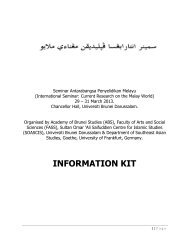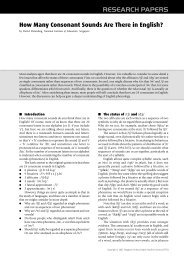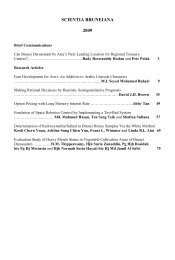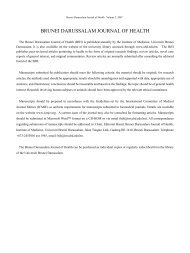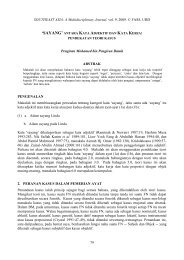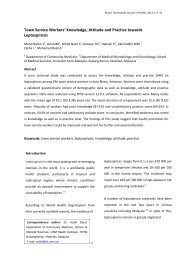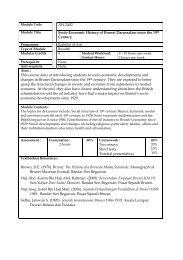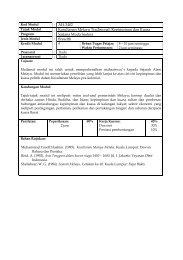cover single page - Universiti Brunei Darussalam
cover single page - Universiti Brunei Darussalam
cover single page - Universiti Brunei Darussalam
You also want an ePaper? Increase the reach of your titles
YUMPU automatically turns print PDFs into web optimized ePapers that Google loves.
<strong>Brunei</strong>: Revival of 1906<br />
Commerce, the <strong>Brunei</strong> Sultan readily accepted. It provided for the setting<br />
up of an American consulate in <strong>Brunei</strong> and allowed American warships<br />
to harbour in its ports. This action violated the terms of the Treaty that<br />
<strong>Brunei</strong> had signed with Britain in 1847. Britain, however, did not raise<br />
immediate objections on diplomatic grounds. It looked as if the Americans<br />
were only looking for commercial opportunities and hardly made use of<br />
the Treaty for political ends, as the British did. Americans themselves<br />
were reticent in acquiring permanent colonies in the Far East.<br />
Three decades later, Britain’s fears of other Western powers did<br />
still persist. Concerned about <strong>Brunei</strong>’s stand vis-à-vis the United States<br />
and Germany, Britain sought further safeguards to bring not only <strong>Brunei</strong>,<br />
but also Sarawak and North Borneo, into a more permanent sphere of<br />
influence. Along with Sarawak and North Borneo, <strong>Brunei</strong> agreed to sign<br />
a Protectorate Agreement with Britain in 1888. This was another<br />
important turning point in <strong>Brunei</strong> history that effectively placed <strong>Brunei</strong>’s<br />
foreign policy in the hands of Great Britain.<br />
Due to the Protectorate Agreement, there were two distinct<br />
limitations on <strong>Brunei</strong>’s ability to re<strong>cover</strong> its lost territories. Firstly, Sarawak<br />
and North Borneo – <strong>Brunei</strong>’s former dependencies – were included among<br />
the foreign states with which <strong>Brunei</strong> could deal only through Her Majesty’s<br />
Government. Secondly, if any disputes arose, the decision of the British<br />
Government would be final. This instantly turned out to be a great<br />
disadvantage for <strong>Brunei</strong> when Charles Brooke annexed Limbang in March<br />
1890, only two years after the Agreement was signed. The British Foreign<br />
Office endorsed the annexation rather unjustly with no concern for<br />
<strong>Brunei</strong>’s geographical and economic predicament – a decision that<br />
increasingly proved difficult to retract.<br />
14<br />
ON THE BRINK OF EXTINCTION<br />
<strong>Brunei</strong> trusted that the Agreement would help to prevent the acquisitive<br />
Brooke from further encroaching on its already shrunken territory. In<br />
1887, Lord Salisbury, in a letter to Sultan Hashim, had promised him<br />
protection as a means of reassuring him before he signed the treaty. Earlier<br />
in 1881, spurning Brooke’s offer of more incentives, Sultan Abdul Mumin<br />
wrote to him that “the territory of <strong>Brunei</strong> was united like unto a man<br />
with all his members complete. At present his arms are lost to him leaving<br />
his head and feet – therefore let it remain so.” So when Brooke aimed at<br />
the heart of <strong>Brunei</strong> by the forcible annexation of Limbang, thereby cutting<br />
<strong>Brunei</strong> into two unconnected enclaves, <strong>Brunei</strong> was left gasping for breath.<br />
Apparently the Protectorate Agreement of 1888 proved inadequate<br />
to safeguard the territorial integrity of <strong>Brunei</strong>. It was worded in a




